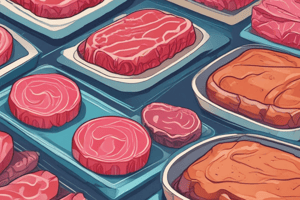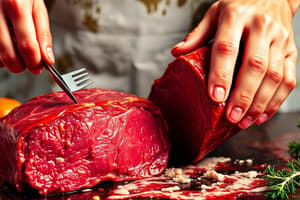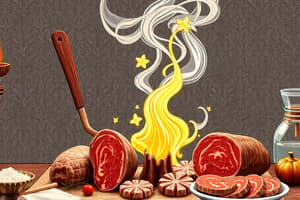Podcast
Questions and Answers
What is the primary reason for allowing meat to rest after cooking?
What is the primary reason for allowing meat to rest after cooking?
- To allow carryover cooking to finish bringing the meat to the desired doneness.
- To allow the juices to redistribute throughout the meat, resulting in a juicier product. (correct)
- To prevent the meat from sticking to the cutting board.
- To lower the internal temperature for safer consumption.
Cooking meat only impacts its tenderness; it has no influence on flavor or digestibility.
Cooking meat only impacts its tenderness; it has no influence on flavor or digestibility.
False (B)
Match the doneness of meat with its corresponding internal temperature (Fahrenheit):
Match the doneness of meat with its corresponding internal temperature (Fahrenheit):
Rare = 120-130°F Medium = 130-140°F Medium-Well = 150-160°F Well Done = 160-170°F
What component of meat is converted to gelatin during cooking, contributing to its tenderization?
What component of meat is converted to gelatin during cooking, contributing to its tenderization?
Unlike collagen, ______ is not changed during the cooking process and is typically trimmed off before preparation.
Unlike collagen, ______ is not changed during the cooking process and is typically trimmed off before preparation.
Which cooking method is best suited for tender cuts of beef like sirloin steak?
Which cooking method is best suited for tender cuts of beef like sirloin steak?
Microwaving is a highly preferred method for cooking meats because it enhances browning and juiciness.
Microwaving is a highly preferred method for cooking meats because it enhances browning and juiciness.
When roasting a whole chicken, at what internal temperature should it be cooked to ensure safety?
When roasting a whole chicken, at what internal temperature should it be cooked to ensure safety?
What is the purpose of 'basting' meat while it is roasting?
What is the purpose of 'basting' meat while it is roasting?
In the context of cooking meat, what does 'denaturation' refer to?
In the context of cooking meat, what does 'denaturation' refer to?
Flashcards
Cooking meats
Cooking meats
Methods to cook meats using moist heat, such as boiling, or dry heat, such as grilling.
Objectives of cooking meat
Objectives of cooking meat
Enhances flavor, tenderizes, improves digestibility, and ensures food safety.
Tenderization of meat
Tenderization of meat
Heat causes muscle fibers to toughen due to protein denaturation when cooking meat, while collagen converts to gelatin, leading to tenderization.
Charcoal grilling
Charcoal grilling
Signup and view all the flashcards
Braising
Braising
Signup and view all the flashcards
Pan Frying
Pan Frying
Signup and view all the flashcards
Pot Roasting
Pot Roasting
Signup and view all the flashcards
Tenderization mechanism
Tenderization mechanism
Signup and view all the flashcards
Stewing
Stewing
Signup and view all the flashcards
Braising poultry
Braising poultry
Signup and view all the flashcards
Study Notes
- Meats can be cooked using moist or dry heat methods, with tough cuts typically cooked using moist heat (e.g., boiling)
- Tender cuts are cooked using dry heat (e.g., grilling)
- Microwaving is not the best cooking method since microwaved meats do not brown well and are less juicy compared to meats cooked using traditional methods
- Meat should rest after cooking, as resting results in juicier meats because cutting into a steaming steak causes juices to escape.
- Cooking meat improves eating quality, digestibility, tenderization, and food safety
Effects of Cooking on Meat
- Cooking affects pigment, protein fiber, protein-bound water, and collagen in meat
- At 100°F/40°C (raw), meat is soft to the touch, translucent, deep red, and protein fibers start to unfold while collagen is in tact
- Protein-bound water accumulates within the cells
- At 120/50°F (rare), meat starts to firm and become opaque, myosin starts to denature and coagulate, more water stays in cell and escapes from it
- At 130/55°F (medium), meat yields to the touch, releases juice when cut, myosin coagulates, and it becomes opaque
- At 140/60°F (medium) the meat shrinks, exudes juice, starts to fade to pink, other fiber proteins denature and coagulate, collagen sheaths shrink, squeezing cells which leads to flow from cells
- At 150/65°F (medium well), the meat continues to shrink, with less free juice as the pink color discolors to gray-brown
- At 160/70°F (well done), meat continues to shrink, it becomes stiff and dry, begins to dissolve to stop flowing
- At 17-75°F (well done) the meat is stiff, dry and gray
- At 180/80°F, actin denatures, coagulates, and cell content becomes densely compacted which causes denaturation and coagulation
- At 200/90°F, fibers separate from each other dissolving rapidly
- Cooking enhances and develops flavors in meat through changes in meat structures, lean, connective tissues, and fat
- Collagen is converted to gelatin through cooking which tenderizes the meat
- Elastin is not impacted by cooking, so it is usually cut off.
- Cooking destroys parasites and pathogenic microorganisms, making meat safe for consumption
Beef/Carabeef Cooking Methods
- Grilling: Suitable cuts: sirloin, rump, porterhouse, and T-bone steak, grill must be preheated and not greased so meat does not stick
- Roasting: Suitable cuts: ribs and sirloin, and whole young calf.
- Cooking internal temperature: 55°C for rare, 71°C for medium, 77°C for well done
- Pot Roasting: Suitable cuts: flank, brisket, rump, top side, and silverside.
- First brown, then place on vegetables, cover, cook on low heat for 45 minutes per half kilo, or cook in a preheated oven at 165°C for 45 minutes per half kilo
- Pan Frying: Tender cuts cut into small/thin sections with only enough fat to cover the bottom of the pan. Cook at high heat, turn only once
- Braising: Similar cuts as pot roasting (brisket, rump, sirloin, etc.) are suitable
- Meat should be browned first in a small amount of fat, then vegetables and liquid can be added. Cover and cook over low heat for 2-3 hours
- Stewing: Used for tough cuts like shin, chuck and flank, or tripe, it can be coated with flour prior or not
- Vegetables can be used, and liquid replenished if needed, cook up to 3 hours depending on cut of meat
- Charcoal Grilling or Inihaw sa Uling: Tender cuts of meat are grilled over charcoal on a parilla. Care is taken to adjust height
- Grease droppings on the hot coal can cause smoke and the surface is burnt but the internal content is still undone
- The type of wood used imparts different acceptable flavors
Pork Cooking Methods
- Grilling and Frying: All kinds of chops can be grilled or fried
- Roasting: All joints are suitable, cook to an internal temperature of 77°C
- Stewing/Boiling: All cuts are suitable for stewing or boiling
- Charcoal Grilling or Inihaw sa Uling: Used for barbecues
Poultry Cooking Methods
- Grilling and Frying: All cuts, whole chicken, and duck may be grilled or fried
- Roasting: Cook to an internal temperature of 75°C.
- When roasting stuffed birds, cook the stuffing separately, then stuff it when the bird is cooked and then cook for a bit longer
- Braising and Casseroling: Good method for all poultry. Can be applied to whole birds including turkey to shorten time
- Braising can be done to fully cook bird, then roasted to brown the surface: leads to less shrinkage
- Charcoal Grilling (inihaw sa uling): Adjust the distance of the meat pieces so that it does not burn before the internal flesh cooks
- Marinating (as in barbecued pieces) may consist of simple 2 or 3 spices like vinegar, salt, and pepper or seasoned marinade from blends of ingredients
- Inihaw is not limited to meats and fish and can be applied to corn, root crops, and other vegetables
Studying That Suits You
Use AI to generate personalized quizzes and flashcards to suit your learning preferences.




